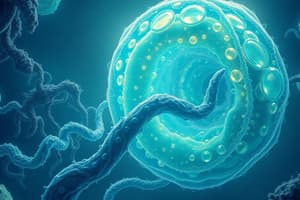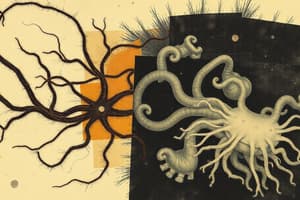Podcast
Questions and Answers
What classification does Entamoeba histolytica belong to?
What classification does Entamoeba histolytica belong to?
Amoebozoa
Which of the following are features of amoebozoa? (Select all that apply)
Which of the following are features of amoebozoa? (Select all that apply)
- Reproduce by binary fission
- Blob-like cells (correct)
- Feed by phagocytosis (correct)
- Cell walls made of cellulose
What is the motility structure used by Entamoeba histolytica?
What is the motility structure used by Entamoeba histolytica?
Pseudopods
Entamoeba histolytica is considered an obligate parasite.
Entamoeba histolytica is considered an obligate parasite.
What parts of the body does Entamoeba histolytica like to infect?
What parts of the body does Entamoeba histolytica like to infect?
Match the infection rates of Entamoeba histolytica in global vs developing countries:
Match the infection rates of Entamoeba histolytica in global vs developing countries:
What are the transmission methods for Entamoeba histolytica? (Select all that apply)
What are the transmission methods for Entamoeba histolytica? (Select all that apply)
What needs to be filtered out of drinking water due to Entamoeba histolytica?
What needs to be filtered out of drinking water due to Entamoeba histolytica?
In the colon, Entamoeba histolytica takes its ___ form.
In the colon, Entamoeba histolytica takes its ___ form.
What is found in formed vs liquid stools for Entamoeba histolytica?
What is found in formed vs liquid stools for Entamoeba histolytica?
Which of the following are different pathology paths for Entamoeba histolytica infection? (Select all that apply)
Which of the following are different pathology paths for Entamoeba histolytica infection? (Select all that apply)
Asymptomatic carriers of Entamoeba histolytica shed millions of cysts per day.
Asymptomatic carriers of Entamoeba histolytica shed millions of cysts per day.
What results from a dysentery infection of Entamoeba histolytica?
What results from a dysentery infection of Entamoeba histolytica?
What characterizes an invasive infection of Entamoeba histolytica?
What characterizes an invasive infection of Entamoeba histolytica?
What can be said about immunity against Entamoeba histolytica?
What can be said about immunity against Entamoeba histolytica?
What is essential information for an accurate diagnosis of Entamoeba histolytica?
What is essential information for an accurate diagnosis of Entamoeba histolytica?
What is the treatment for the intestinal phase of Entamoeba histolytica infection?
What is the treatment for the intestinal phase of Entamoeba histolytica infection?
What is the treatment for the invasive tissue phase of Entamoeba histolytica?
What is the treatment for the invasive tissue phase of Entamoeba histolytica?
Which parts of the body can Entamoeba histolytica infect through dissemination? (Select all that apply)
Which parts of the body can Entamoeba histolytica infect through dissemination? (Select all that apply)
What are adhesions of Entamoeba histolytica to infected areas called?
What are adhesions of Entamoeba histolytica to infected areas called?
Flashcards
Amoebozoa
Amoebozoa
Classification group that Entamoeba histolytica belongs to.
Pseudopods
Pseudopods
Motility via temporary cytoplasm-filled extensions.
Obligate parasite
Obligate parasite
An organism requiring a host to complete its life cycle.
Fecal-oral transmission
Fecal-oral transmission
Signup and view all the flashcards
Cyst (E. histolytica)
Cyst (E. histolytica)
Signup and view all the flashcards
Trophozoite (E. histolytica)
Trophozoite (E. histolytica)
Signup and view all the flashcards
Dysentery (E. histolytica)
Dysentery (E. histolytica)
Signup and view all the flashcards
Invasive infection (E. histolytica)
Invasive infection (E. histolytica)
Signup and view all the flashcards
Liver abscess formation
Liver abscess formation
Signup and view all the flashcards
RBCs in trophozoites
RBCs in trophozoites
Signup and view all the flashcards
Travel history
Travel history
Signup and view all the flashcards
Paramomycin
Paramomycin
Signup and view all the flashcards
Metronidazole
Metronidazole
Signup and view all the flashcards
Adhesions
Adhesions
Signup and view all the flashcards
Study Notes
Classification and Characteristics
- Entamoeba histolytica belongs to the classification group Amobozoa.
- Characteristics of Amoebozoa include blob-like cells and feeding through phagocytosis.
Motility and Parasitic Nature
- E. histolytica exhibits motility via pseudopods.
- Functions as an obligate parasite, requiring a host to live.
Infection Preferences and Rates
- Primarily infects luminal intestinal membranes, sometimes invading intestinal tissue.
- Infection rates show 10% globally and up to 50% in developing countries.
Transmission Routes
- Transmitted through fecal-oral ingestion, direct contact, and anal-oral sexual activities.
Environmental Presence
- Can contaminate water sources, necessitating filtration for safe drinking water.
Infection Process
- Infection initiated by ingesting a cyst.
- In the colon, E. histolytica adopts the trophozoite form.
Stool Analysis
- Cysts identified in formed stool; trophozoites found in liquid stool.
Pathology Variations
- Three main pathology pathways: asymptomatic mild, dysentery, and invasive infection.
- Asymptomatic carriers can shed millions of cysts daily.
Symptoms of Dysentery and Invasive Infection
- Dysentery results in severe bloody diarrhea due to colonic epithelium invasion.
- Invasive infections lead to body-wide dissemination, including liver abscess formation.
Immunity and Diagnosis
- Limited immunity against E. histolytica exists in the population.
- Diagnosis involves identifying cysts in formed stool, trophozoites in bloody diarrhea, and examination for RBCs in trophozoites from pathogenic strains.
- Travel history is essential for an accurate diagnosis.
Treatment Options
- Intestinal-phase infections treated with paramomycin.
- Invasive tissue-phase infections treated with metronidazole.
Potential Sites of Dissemination
- Can infect various body parts: brain, lung, liver, skin, and genitalia.
Abscess Formation
- Adhesions occur in infected areas due to E. histolytica, leading to abscess formation.
Studying That Suits You
Use AI to generate personalized quizzes and flashcards to suit your learning preferences.




